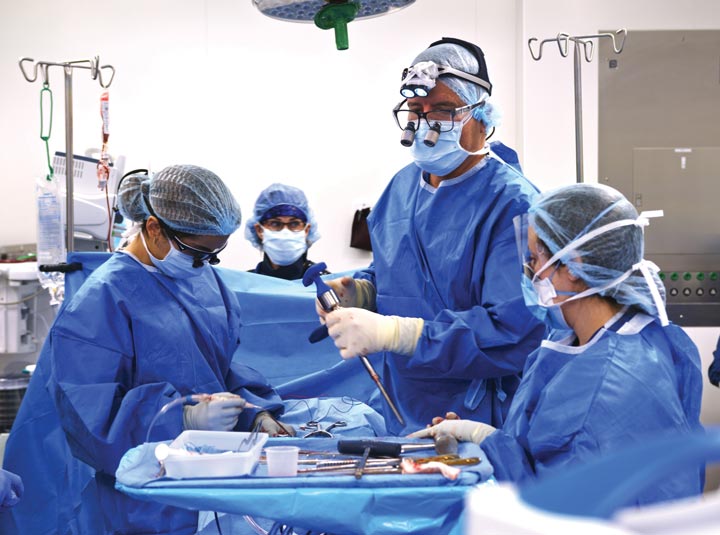- Home
- Article
The Secret to Controlling Pain After Spine Surgery
By: Kendal Kloiber | Contributing Editor
Published: 2/20/2025
Innovative techniques, tailored care and preoperative education are transforming postoperative patient experiences.
Managing patients’ pain after their spine surgeries is critical, especially when those surgeries are performed in outpatient settings. Fortunately, advancements in surgical techniques and pain management address those concerns while driving the migration of many of these procedures from inpatient hospitals to freestanding surgical centers.
Patient-centered pain control
At VSI, an ASC formerly known as Virginia Spine Institute in Reston, the approach to controlling postoperative pain begins long before the procedure.
“It’s all about setting expectations and keeping patients informed,” says William Kemp, MD, a neurosurgeon at VSI. “A well-educated patient understands that some pain is part of the process, but they’re better equipped to manage it.”
He knows that a patient-centered approach that blends preoperative education, minimally invasive surgical techniques and multimodal analgesia strategies reduces pain, minimizes complications and ensures smoother recoveries.
Let’s look at how a holistic approach to pain control after spine surgery can improve patients’ experiences.
Preoperative education
Proper preoperative education should be the cornerstone of any surgical pain management strategy, regardless of the specialty. The importance of clear communication with the patient begins during their very first office visit, emphasizes Dr. Kemp. VSI’s patients are routinely informed about what to expect before, during and after surgery.
“Only about 10% of our patients go on to have surgery,” he says. “For those who do, we make sure they understand what to expect every step of the way.”
Setting realistic expectations is key. VSI’s patients go into their surgical experience with their eyes wide open, knowing they may experience some postoperative discomfort, particularly at the incision site, and also aware that the pain will be manageable and temporary.
“If they understand that some discomfort is normal and temporary, they’re much more likely to feel satisfied with their recovery,” says Dr. Kemp.
He also stresses the importance of early mobilization — something patients may not expect. “Patients often think they’ll be bedridden after spine surgery, but it’s quite the opposite,” he says. “We want them up and walking as soon as possible.”
Early mobilization aids in recovery and prevents complications such as blood clots, pneumonia and muscle atrophy. It’s a cornerstone of VSI’s recovery approach, regardless of whether a patient undergoes a minor decompression or a more complex fusion.
Minimally invasive techniques
Thanks to the latest advances in robotics and neuro-navigation, an ever-growing number of spine surgeons are exploring minimally invasive, muscle-sparing techniques that reduce tissue damage and inflammation.
“Using these tools, we can perform precise surgeries through smaller incisions,” says Dr. Kemp. “This approach decreases postoperative pain and helps patients get back on their feet faster.”
However, newer doesn’t always mean better, cautions Dr. Kemp. Due to the steep learning curve for minimally invasive spine surgery, surgeons must become comfortable operating with a less direct view of the surgical site.
“It’s about what works best in the surgeon’s hands and meets the patient’s expectations,” he says.
Multimodal pain management
Dr. Kemp and his anesthesia team collaborate to employ a multimodal pain management approach that combines several preemptive analgesic strategies to target different pain pathways.
“A local anesthetic block around the incision site works wonders, particularly in the first 24 to 36 hours after surgery,” says Dr. Kemp.
Nonsteroidal anti-inflammatory drugs (NSAIDs) are used selectively. For decompressions and disc replacements, NSAIDs effectively reduce inflammation and pain. However, they’re avoided for fusion surgeries to allow proper bone healing.
Dr. Kemp and his team also administer medications such as gabapentin and muscle relaxants like methocarbamol as part of their arsenal.
“We’re attacking the pain from multiple angles,” he explains. “It’s about finding the right combination for each patient.”
Physical therapy

Physical therapy is essential for pain management not just after surgery but also before. For patients who come to VSI with back pain, the first step of their treatment is PT.
“Getting patients into prehab before surgery helps them build strength and mobility, which leads to better outcomes postoperatively,” says Dr. Kemp.
After surgery, VSI’s PT program focuses on keeping patients mobile to prevent complications such as blood clots and muscle spasms while rebuilding their strength. “The human body is meant to move,” says Dr. Kemp. “When we’re sedentary, that’s when the real problems begin.”
A customized approach
Dr. Kemp is optimistic about the future role of emerging technologies in pain management. Advances in endoscopic spine surgery and regenerative medicine such as stem cell therapy and platelet-rich plasma injections are paving the way for less invasive and more effective treatments that help to control patients’ pain.
Treating each patient as an individual, offering an array of tailored approaches to meet their needs and helping them achieve the best possible outcome every step of the way is the blueprint for delivering those results.
“We’re entering an era of ultra-minimally invasive techniques,” says Dr. Kemp. “We’re not a one-trick pony. Our practice has an extensive tool belt of options. That’s modern spine care.” OSM
.svg?sfvrsn=be606e78_3)
.svg?sfvrsn=56b2f850_5)